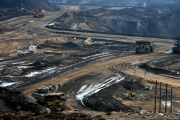Which country possesses the world's largest oil reserves, occupies last place in the international Climate Change Performance Index and complains most loudly about the Kyoto Protocol? Many followers of international affairs may have no difficulty naming Saudi Arabia.
But if asked which country comes a close second on each of these measures, far fewer may know that it is Canada. The country has traditionally been seen as a constructive actor on global issues. Yet Canada has failed for years to control its rising greenhouse gas emissions, and the present government (led by Prime Minister Stephen Harper) has attracted unprecedented criticism for its stance on climate change. Many point to Canada's burgeoning oilsands industry as the root of the problem.
How bad is Canada's record on emissions? Why has the Harper government been so heavily criticized? And what are the true reasons for its reluctance to take strong action on climate change?
Despite being only 36th in the world by population, Canada is eighth in the world for greenhouse gas emissions, producing over two times more per person than Spain. A cold climate and long intercity distances are part of the explanation. But bigger reasons are Canada's reliance on energy-intensive, fossil fuel-based industries and the country's sprawling cities with too many large, inefficient vehicles and buildings.
Canada's greenhouse gas emissions rose by 24%t between 1990 and 2008 — the result of economic and population growth in the absence of adequate government efforts to clean up the country's energy systems. And without new government policies, emissions are projected to continue growing even more quickly. This is a very different scenario than the one Canada committed to under the Kyoto Protocol — one in which Canada's emissions were to fall to 6% below the 1990 level by now, with an expectation of deeper cuts to follow.
And yet the carbon-intensive nature of Canada's economy means it offers many opportunities to cut emissions. A 2009 study by M.K. Jaccard and Associates, a leading economic modelling firm, concluded that Canada could sharply reduce its emissions between 2010 and 2020 with only a slight slowing of economic growth, and no negative impact on job creation. This would require immediate implementation of strong government policies both to increase energy efficiency and to change the ways that Canada produces energy. More than anything else, the country needs to put a substantial price on emissions through a carbon tax and/or "cap-and-trade" regulations.
Failing to curb emissions
Stephen Harper became prime minister at the beginning of 2006, as leader of a Conservative Party that had been openly skeptical about climate change. (In 2002, Harper had denounced the Kyoto Protocol as a "socialist scheme" that is "based on tentative and contradictory scientific evidence.") The newly elected Conservative government publicly accepted human-caused climate change, but it shelved the previous government's plan to regulate industrial emissions (half of Canada's total), cancelled major spending programs aimed at reducing emissions and rejected Canada's Kyoto emissions target.
With regard to Kyoto, the Harper government could say with some justification that its predecessor had left it in a difficult situation, with emissions far above the target and little time left to act. The country's failure to comply with the Kyoto Protocol has now become an accepted fact within Canada, and it is no longer much mentioned in public debate. But outside of Canada's borders, there continues to be dismay that Canada is thumbing its nose at international law. The country is not even making any meaningful attempt to come closer to compliance, despite the "flexibility mechanisms" (emissions trading) available to countries in Canada's position.
The Harper government has now adopted a target to cut greenhouse gas emissions to 2% above the 1990 level by 2020, and has put this forward in international negotiations. But the government has produced no legislation or plan to meet this target, and experts agree that the government's current policies have no chance of reaching it. It is therefore difficult to avoid the conclusion that Canada's greenhouse gas target is for the government's public relations purposes only.
The government is implementing a few policies that can somewhat slow the future growth in Canada's emissions. The most significant ones are regulated emission standards for cars and trucks, stronger efficiency standards for energy-using equipment and public investment in four industrial-scale projects to capture and store carbon dioxide. The government is also proposing to regulate emissions from coal-fired electricity generation, starting in 2015.
But there are question marks about the effectiveness of most of these initiatives. Analysis by the Pembina Institute, a sustainable energy think tank, shows that loopholes in the car regulations may allow automakers to simply continue with business-as-usual. Some of the carbon capture projects may not proceed, if their proponents decide they are not economically viable. The regulations for coal-fired electricity will allow existing plants to operate for their full economic life (45 years), and will allow new ones to avoid capturing most of their emissions until 2025.
Nearly five years after taking office, the Harper government currently has no specific proposal to put a price on greenhouse gas emissions or to limit greenhouse gas pollution from industry. The most significant federal spending programs to support energy efficiency and renewable energy, which were resurrected in 2007, have now run out of money. Overall, there are no federal policies in place or proposed that substantially change the projections that Canada's emissions will keep growing.
Falling behind internationally
The government justifies this situation by insisting on the need to harmonize policies with the United States, arguing that this is needed to protect Canada's economic competitiveness. But there is little convincing evidence to support this claim: instead, economic studies indicate that only small segments of Canadian industry would face major competitiveness impacts even if they faced a substantially higher price on emissions than their U.S. counterparts. For example, the C.D. Howe Institute, a business-oriented think tank, says that initiating a Canadian cap-and-trade system for greenhouse gas emissions without waiting for the U.S. would be a "low-risk strategy."
Doubts over the Harper government's sincerity about harmonizing with the U.S. are fuelled by Canada's failure to match its southern neighbour on key climate policies. Analysis by the Pembina Institute found that for fiscal year 2010/11, the Obama administration had proposed 18 times more new spending on renewable energy, per capita, than the Government of Canada. Also, the Obama administration will begin regulating greenhouse gas emissions from some industrial facilities in January 2011, but there is no sign yet that Canada will do the same.
It is important to note that Canada's provincial governments can act to reduce greenhouse gas emissions on their own. Many of them are taking more significant action than the federal government. But current provincial initiatives will not be enough to stop Canada's emissions from continuing to rise.
In international negotiations on a new global climate treaty, the Harper government has been out of step with most other developed countries. At the conclusion of the 2007 UN climate conference in Bali, Canada and Russia were alone in publicly opposing a science-based target for industrialized countries' emissions. Assessing last year's Copenhagen climate conference, the Globe and Mail, Canada's most prominent national newspaper, concluded: "among developed countries, it [Canada] stood alone in its apparent apathy."
In 2010, Stephen Harper opposed making climate change a priority issue for the G8 and G20 summits hosted by Canada. European Commission President Barroso and Mexican President Calderón both offered public critiques of Canada's policy of waiting for U.S. action on climate change. And in a closely related area, Canada remains the only G8 country apart from Russia not to have joined the newly created International Renewable Energy Agency.
Why is Stephen Harper's government so resistant to ambitious action on climate change? There appear to be four main reasons that overlap and reinforce one another.
An "apparent disregard for science-based policy"
First, climate change is a science-driven issue. The imperative to cut emissions comes directly from warnings by the world's most prestigious scientific institutions. But Stephen Harper's government has become known for what Nature, the international science journal, calls its "apparent disregard for science-based policy" — not just policy on climate change, but also on health issues and census data.
It is certainly difficult to explain the government's performance on climate change without supposing that many Conservative ministers and members of parliament must remain privately skeptical of the overwhelming scientific case for action. It would be impossible to imagine the government adopting a policy of "let Washington decide" on an issue that the government does truly believe in, like defence or economic management.
Second, many Canadian opinion leaders of all political stripes have an exaggerated fear of the economic costs of reducing greenhouse gas emissions. In part, this is a consequence of years of lobbying by industry associations. It also flows from the commonly held view that any constraint or extra cost must necessarily be bad for business. There is very little awareness of the economic studies that consistently show large emission reductions can be achieved with only small effects on GDP.
Canada's oilsands, concentrated in the province of Alberta, are without doubt a major factor in the view that ambitious action to cut the country's emissions would be economically unfeasible. The oilsands are the reason why Canada's oil reserves are almost as great as those of Saudi Arabia. The industrial infrastructure to extract the oil already consumes vast amounts of energy, water and land, with production currently running at 1.8 million barrels per day. But projects that have already been approved would increase that to 4 million barrels. Counting all announced projects, production could eventually approach 8 million barrels per day.
So while the oilsands industry accounted for just 5% of Canada's greenhouse gas emissions in 2008, oilsands operations are projected to account for nearly half of a substantial increase in Canada's emissions between 2006 and 2020, in the absence of new government policies. As a result, some decision-makers fear that constraints on emissions would lead to a loss of billions of dollars of investment in oilsands expansion.
Yet the economic study by Jaccard and Associates cited above showed that Canada could surpass the federal government's greenhouse gas target for 2020 while still expanding the oilsands industry, and stiill allowing Alberta to have the fastest growing economy in the country. This would be achieved by slowing the rate of oilsands expansion and requiring the industry to capture its emissions on a large scale.
Betting on global inaction
The Harper government appears, however, to take the view that the oilsands are a competitive advantage for Canada so precious that as little as possible should be done that might limit their growth. This kind of thinking might also explain why the government has shown so little interest in renewable energy: given that Canada has made a slow start with wind and solar power, why bother trying to compete with the U.S. or Europe, which are so much further ahead? The problem with this reasoning is that it amounts to a bet that the world will not seriously tackle climate change.
The oilsands also loom large in a third reason for the Harper government's resistance to action on climate change: the ability of Alberta, or any other major province, to frustrate national initiatives that they oppose. Canada's provinces have considerable powers over energy and climate policy and carry considerable political weight. Some rely heavily on fossil fuels and have very high greenhouse emissions; others use hydroelectricity and have much lower emissions. It will take a determined federal government to design and implement a national climate policy that successfully navigates between these divergent regional interests.
A fourth and final explanation for the Harper government's choices on climate policy can be found in electoral politics. During nearly five years in office, the government has never had a parliamentary majority; an election could therefore occur at almost any time. This has led all the political parties, especially the one in power, to focus constantly on short-term electoral advantage. The government's calculation appears to have been that the new voters it can most readily attract are not motivated by concern about climate change.
It is far from clear that this calculation is correct. Almost half of Canadians say that climate change is a problem that is both very important and very urgent to solve. Two-thirds of Canadians say that it is very important for the federal government to "lead the international fight against climate change," while only 14% say that the Harper government is performing well on this issue, according to a poll by the Gandalf Group for the Climate Action Network Canada in June 2010.
These numbers provide some hope that Canada need not forever remain the Saudi Arabia of North America.






